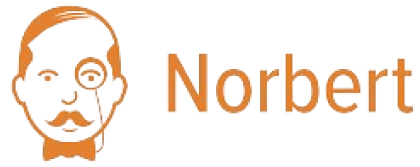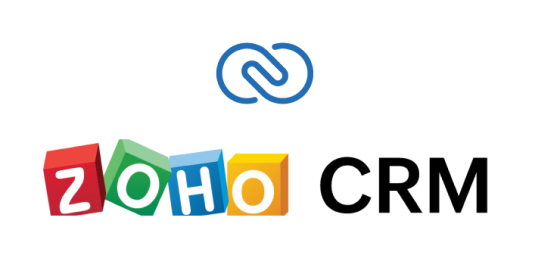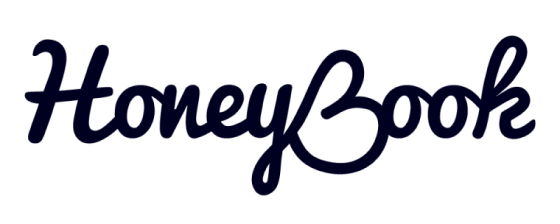
Salesforce Sales Cloud CRM Review 2025 | Features & Tools
My Verdict
I prefer a free version to be available for startups or small companies. However, the 30-day free trial allows businesses to test their desired package. With its variety of solutions and phenomenal features, I rate this software 4.5/5.
- Exceptional range of tools
- Multiple packages for scalability
- Globally-trusted brand
- 30-day free trial without needing credit card details
- Generative and predictive AI capability
- No free version
- Packages can be on the expensive side
- Complex onboarding process
Integrations
What Does Salesforce CRM Do?
Salesforce is one of the most recognizable names in the industry. It delivers a comprehensive solution for customer relationship management. Salesforce is seen as the number one CRM all-in-one customizable solution globally, and as of the end of 2022, 59% of the brand’s clients are from the US.
Part of the reason so many like Salesforce is its customization. I found it has various paid packages and features that let you pick and choose what tools you need for your business. It also has dedicated sections for Sales, Service, Marketing, Commerce, and more.
These sections will help a company focus on areas for improvement or where it needs more structure. Each section also boasts multiple tools. As such, even if you sign up for the marketing suite, you can track progress and generate potential customers.
As of 2024, over 150,000 businesses reportedly used Salesforce, which shows its strong position. Salesforce also unites all its features in a single app usable on desktop, tablet, or mobile devices.
Salesforce’s CRM Features
To answer the question “What is Salesforce sales cloud?” I examine the primary features. Taking a closer look at these features will highlight how this software can enhance your business operations and help you better understand what this tool is all about.
Contact Management:
Salesforce goes the extra mile to deliver a cohesive view of all your contacts and their interactions. Customer 360 presents a shared view of every customer to ensure you can enhance your relationships with them.
You create your Customer 360 view using the brand’s integrated Einstein 1 AI software. There’s also the Customer Data Platform, which presents the following features:
- Data Mapping: Map data from your clients to create a cohesive view of their profiles. This tool has a click-and-drag feature and is easily shareable with team members. Mapping data means even downstream CRM systems can react appropriately to the client.
- Segmentation: Prioritize and segment customers into various groups. It helps you access targeted audiences much faster. It also assists in finding new clients that fit the created profiles.
- Data-Driven Customer Journeys: Personalize the client’s journey using their data insights. AI drives customer engagement to determine the next step in their journey. This tool ensures clients experience a more tailored journey and gain faith in the brand.
- Calculated Insights: Data Cloud’s calculated insights can help a sales rep understand clients. It shows how customers react to campaigns and lets you base campaigns and marketing efforts on customer information. It also enables you to optimize your performance through segmented customer lists by targeting the right clients with specific offers.
Opportunity Management:
The sales section is all about creating opportunities and driving revenue. This feature uses Einstein 1’s AI insights to determine when you have the best sales opportunities. It has various tools to help you get the specific insights you want.
These include the Sales Engagement and Program features. Each of these features has various tools to help you better manage opportunities:
- Engagement Intelligence: AI will analyze customer interactions to present the best opportunities. It will recommend your next step and help you improve your deals with valuable insights.
- Customer Signals: Call insights will help you improve your client communications. It analyzes competitors, pricing, objections, and questions asked. In this way, it determines what a customer is after.
- Guidance Center: Learn how to communicate better with your customers via the Guidance Center. It has videos, guides, scripts, and templates sales reps can use to learn how to identify opportunities.
- Revenue Milestones: Use the sales program to track specific goals and revenue. By adding activities and targets into the program, the sales reps can keep up with their opportunities and sales.

Personal screenshot, 23 April 2023
Sales Cloud:
The sales cloud has multiple features that will help drive your sales and revenue. However, it doesn’t work alone; the Sales Analytics and Team Productivity sections also contribute. With these sections working together, it’s almost guaranteed you’ll see enhanced sales.
To better understand how these divisions improve your sales, I look at some of the primary tools you can use:
- Activity Management: Automate specific tasks like capturing emails and events in the CRM. You can prioritize specific activities and see all of them in one spot for easy access.
- Lead Management: AI helps you prioritize the best leads based on their profiles. It enables tracking and managing leads across various channels and increases your sales reps’ efficiency.
- Pipeline Management: Manage your pipelines on a single screen. This comprehensive view of pipelines means you can easily maintain them and see if there are gaps within the charts.
- Opportunity Health Signals: See when a lead is close to converting with this tool. It helps you spot the factors that contribute to lead conversion. It also shows how close the lead is to converting, so you’ll know when to push it and when to leave it.
- Team Goal Tracking: Collaborate with team members to increase efficiency. Goal tracking optimizes teamwork by showing individual and team goals. It works as a KPI dashboard linked with your team activities.
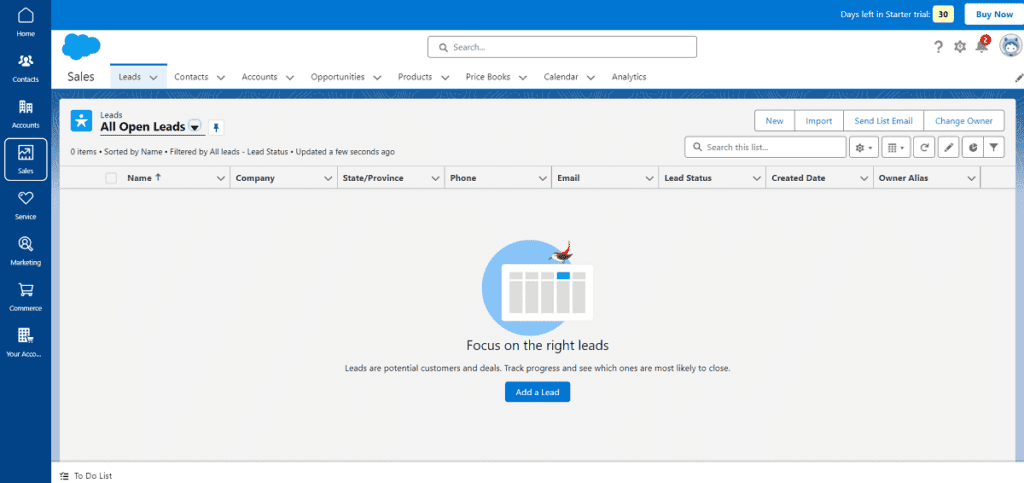
Personal screenshot, 23 April 2023
Marketing Automation:
Marketing automation is crucial for any company, as it helps create more effective operations. Part of Salesforce’s CRM system is providing a comprehensive marketing automation division. Together with its AI and Analytics division, this feature offers the following tools:
- Lead Generation: Create forms and effective landing pages through drag-and-drop builders. Generate more leads with an appealing website design and the below tools.
- AI Scoring: Einstein 1 leverages lead behavior and activity to score the lead. It determines how likely they are to convert and focus the sales reps’ efforts. Determine whether the lead matches your company’s ideal client profile.
- Account-Based Engagement: Monitor client and lead accounts to find the ones with the best activity. You can target and engage with these accounts to drive sales and conversion.
- Automated Marketing Data Model: Create an out-of-the-box data model using data classifications and naming convention patterns. It organizes data clearly and lets you easily view critical statistics and data points.
- AI Automated Offers: Einstein 1 will analyze the customer profile and request to create the ideal offer. By examining your stated goals and the client requests, this predictive AI can generate automated AI offers that are most likely to convert a lead.

Personal screenshot, 23 April 2023
Workflow Automation:
A shoddy workflow is one of the worst things to have, as it heavily impacts your team’s productivity. On the other hand, a streamlined workflow enhances productivity and customer satisfaction. It ensures team members can work together smoothly and acts as damage control if something goes wrong.
Luckily, you can implement better workflows for your teams with Team Productivity, Performance Management, and Incentive Compensation. While there are various ways you can drive workflow, the following tools are ones that stood out to me:
- AI-Ready Workflows: Automate tasks and even the most complex workflows to streamline your operations. With this automation, you can ensure pipeline management and approvals happen as fast as possible.
- Sales Dashboard: The dashboard summarises key metrics, accounts, opportunities, and deals. It’s the ideal platform to see all your workflow operations at a glance.
- Automated Activity Tracking: When you automate tasks/workflows, you can also automatically track activities. This tool logs calls, emails, and meetings in the Sales Cloud so your sales reps can better spend time chasing critical leads.
- Automated Territory Design: An optimization engine automatically balances territories. It saves your sales reps from manually testing and planning scenarios to gather data. Maximize your business’ coverage with these automatic territories, boost sales, and reduce travel costs.
- Powerful Automation: You can automate more than just the basic workflows. You can also automate tiers, triggers, commission structures, and accelerators. All of these tools help your workflow move along more smoothly.

Personal screenshot, 23 April 2023
Enhanced Reports and Dashboards:
Each division will have comprehensive dashboards that allow you to manage your operations. There’s the overall dashboard, but you can also find dashboards for specific tools and features. You’ll also find analytics and enhanced reports that help you understand how your business is doing.
While there are specific tools in each section, I talk about the overall feature and how you can use it. It includes:
- Sales Analytics: Manage your sales in real time using adaptable forecasts. Multi-org forecasts, deal and customer insights, and a pre-built sales dashboard are also available. You can monitor and generate reports on sales to ensure you know what’s happening.
- Marketing Analytics: Use these analytics to see how successful your marketing campaigns are. The API connector library provides over 170 connectors to present detailed insights. You can also export your data using Tableau and gain insights into advertisements.
- Automated Expense Reporting: This tool generates audit-ready expense reports. It ensures your company complies with the ASC 606 and IFRS 15. Manage fringe benefits, exceptions, and different commission types for these reports.
- Record-Mapped Channels: Use Slack channels to check your team’s productivity and performance. You can find opportunity records, see team members’ latest activities and deals, and collaborate on projects using data-driven insights and analytics.
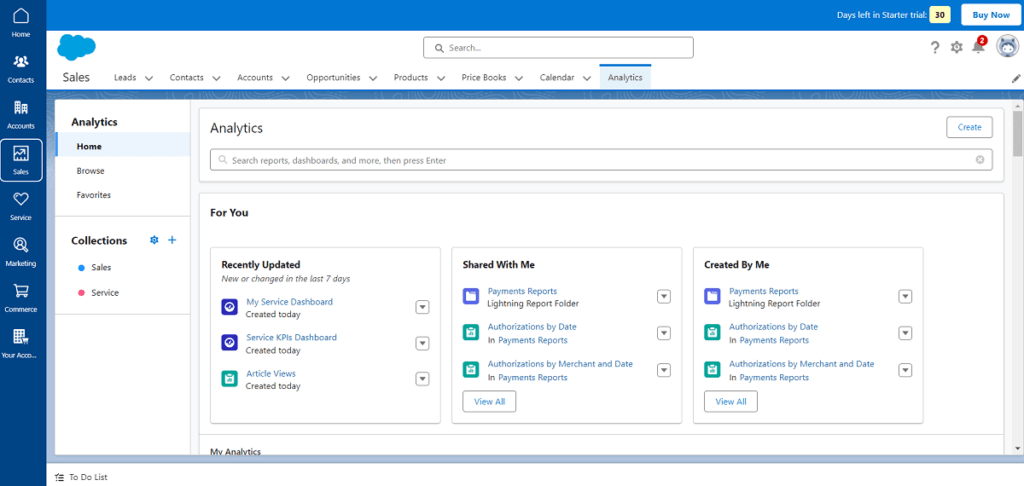
Personal screenshot, 23 April 2023
Community Cloud:
The Community Cloud is your chance to build your community from the ground up. You can connect with clients, grow partner sales, and empower employees with a detailed community.
Personalize your cloud to fit your business needs and brand, and collaborate with others using any device.
You can also provide customers with the necessary knowledge and action sales force automation for better partner sales. It features the following tools:
- Chatter Collaboration: Ensure employees are always aware of the latest changes. This feed lets your team members communicate and collaborate from one central platform.
- Business Integration: Integrate digital experiences into your business. You allow partners and clients to engage more fully with your company. It includes letting them qualify leads, update opportunities, or escalate support cases.
- Experience Management: Lightning dashboards ensure you can measure specific metrics. These metrics include engagement, adoption of software or products, users, popular groups, and more. See what your customers are interested in to deliver a tailored experience.
- Data Sharing: Better manage your partners by selecting what information gets shared with them. Let partners move opportunities through your different pipelines based on your goals and deals. It also lets you connect them with product experts to market your product further.
Salesforce’s Multiple Integrations
This brand features third-party integrations to help your business run more smoothly. You can still manage everything from one platform after integrating the apps you use. Integrations also help support Salesforce’s operations, strengthening any areas lacking the software.
Salesforce further has some third-party integrations that are integral to its various divisions. These integrations, along with a few other popular ones, are:
- Slack
- Tableau
- Heroku
- Google Cloud
- Quickbooks
- MailChimp
- DocuSign
- Jira Software
- HelloSign
- CodeScience
- DropBox
- ActiveCampaign
Pricing Plans and Packages
Salesforce offers a comprehensive selection of pricing plans and packages. This variety of plans means it’s relatively easy to scale the software to fit your business requirements. The following packages for the main features are all available:
Small Businesses:
- Starter Suite: $25/user/month
- Pro Suite: $100/user/month
You can add various extra features to this package, such as:
- Marketing Account Engagement: From $1,250/month
- Sales Cloud Enterprise Edition: From $165/user/month
- Service Cloud Enterprise Edition: From $165/user/month
Sales Suite:
- Starter: $25/user/month
- Professional: $80/user/month
- Enterprise: $165/user/month
- Unlimited: $330/user/month
- Einstein 1 Sales: $500/user/month
Service Suite:
- Starter: $25/user/month
- Professional: $80/user/month
- Enterprise: $165/user/month
- Unlimited: $330/user/month
- Einstein 1 Sales: $500/user/month
Marketing Suite:
- Marketing Cloud (MC)Engagement: From $1,250/org/month
- MC Account Engagement: From $1,250/month (up to 10,000 contracts)
- MC Growth Edition: $1,500/month
- Data Cloud for Marketing: $108,000/org/year
- MC Personalization: From $108,000/org/year
- MC Intelligence: From $3,000/org/year
- Loyalty Management: From $20,000/org/month
- Referral Marketing: From $12,500/org/month
Commerce:
- B2C Commerce: Starting at 1% Gross Merchandise Value (GMV)
- B2B Commerce: Starting at 1% GMV
- D2C Commerce: Starting at 1% GMV
- Order Management: 1% GMV/order
- Connected Commerce: Starting at 1% GMV
Most of the packages are billed monthly or annually. However, if it states a price per year, like the Data Cloud for Marketing plan, it’s always an annual billing. There are also other pricing plans available for:
- Tableau
- MuleSoft
- Slack
- Platform
- Net Zero
- Industries:
- Success:
- Work.com
Is Salesforce CRM User-Friendly?
Once you familiarize yourself with it, this software is one of the most customizable and user-friendly options. However, it typically has a more complex onboarding process, often requiring expert help to adopt the software successfully.
Due to the many different features and tools available, it might take some time to familiarize yourself with its inner workings. However, you’ll find many customizations available once you’ve become used to how it works.
These custom dashboards allow you to arrange and design the dashboard in a way you and your employees can easily use. It’s one of the primary reasons this software is considered user-friendly despite its complex onboarding.
Luckily, even though the adoption process can be challenging, the brand provides multiple resources. The Learning Center and Help Desk provide most of the information needed to set up your account.
When you first create an account, tips and hints will also be available to get you started. All of this ensures it doesn’t take long to familiarize yourself with how the software operates.

Personal screenshot, 23 April 2023
Is Salesforce Suitable for Small Business Needs?
Studies have shown that of the businesses that use this software, around 49% are small businesses with less than 50 employees. Around 40% are mid-sized, while only 11% are large enterprises with over 1,000 employees.
That’s not to say the software isn’t suited for large businesses. Around 7,500 enterprises with annual revenue over $1 billion still use it. However, some research shows that it is most popular with businesses with annual revenue between $1 million and $10 million.
While Salesforce’s management software is top-tier, its generative AI and growth features make it a good choice for smaller businesses. Its automated pipelines, predictive AI, data-driven insights, and customer 360 views are all ideal tools for establishing excellent workflows.
It also enhances their daily operations and teaches them how to recognize the best opportunities and marketing tactics. However, I found that Salesforce is on the slightly expensive side. As such, it might not be ideal for small companies or startups with a tight budget.
How Does the Free Version Hold Up to the Paid Version?
While this software is excellent for small businesses, it does not offer a free version. However, while there’s no free version, you can test all paid plans using the 30-day free trial. This trial doesn’t require your credit card details to sign up, meaning you can cancel your “trial subscription” without any fees.
The trial offers the same features as the package, meaning you can thoroughly test it with zero obligation. Further, as you can test it for 30 days instead of only seven or 14, you can learn the real impact this software will have on your company.
Which Companies Use Salesforce CRM?
Global brands trust and use this software, with some recognizable names among them. I found sources that state its user companies include big names like:
- Amazon Web Services
- The New York Post
- U.S. Bank
- Walmart
- Macy’s
- T-Mobile
- L’Oreal America
- American Express
- The Hershey Company
However, on the official website of this brand, you can also see customer success stories and highlights. These include companies like:
- Iron Mountain
- BACA Systems
- Wonolo
- Crexi
- IHG Hotels and Resorts
- London Stock Exchange Group
- McLaren Racing
- Heathrow Airports
- Simplyhealth
- Avon
- Xerox
- Intel
Best Alternative Software
While many consider Salesforce the number one CRM software, you might need something else to fit your company. Whether it’s too expensive, its plans are too limited, or you want something with a more straightforward onboarding process, I understand the need for alternative options. Some of the best alternatives to this software are:
- HubSpot
- FreshSales
- Outreach
Our Suitability Assessment
Knowing what this CRM solution is all about doesn’t necessarily mean you immediately know whether it suits your business. That’s why I will discuss the main factors that influence whether you use this CRM software or other CRM solutions.
Choose Salesforce If:
- You want a comprehensive CRM marketing and service cloud
- Your company budget allows for more high-end packages
- You require a small business startup pack
- You want access to a comprehensive knowledge base
- You need a scalable CRM option
- Your business requires intensive management and analytics
Avoid Salesforce If:
- You need a free version or have a strict budget
- You want a more user-friendly onboarding process
- You require more straightforward features to get you started
- You don’t like the interface and want something less complex
Salesforce Resources: Essential Guides and Tutorials
Salesforce Flow Examples
Explore five different types of Salesforce Flows, including when and how to utilize them, the construction process, frequent pitfalls, and important takeaways.
Salesforce Flow Examples
2024 Salesforce Guide: How to Share a Report in Salesforce
Learn how to share a Salesforce report effectively with our easy-to-follow guide. Discover step-by-step instructions, tips for secure sharing, and best practices to enhance collaboration in your team.
2024 Salesforce Guide: How to Share a Report in Salesforce
How To Create A Task In Salesforce
Salesforce Tasks are the CRM platform’s version of a to-do list. Learn how to create a task in Salesforce to add action items to a user’s “to-do” list.
How To Create A Task In Salesforce
How To Create An Email Template In Salesforce
In this guide, we will explore how to create an email template in Salesforce Lightning, how to enable Content Builder, how to set up email templates, and more.
How To Create An Email Template In Salesforce
How to Create a Custom Object in Salesforce
Discover how to create a customized and unique object within your Salesforce organization with this step-by-step guide.
How to Create a Custom Object in Salesforce








